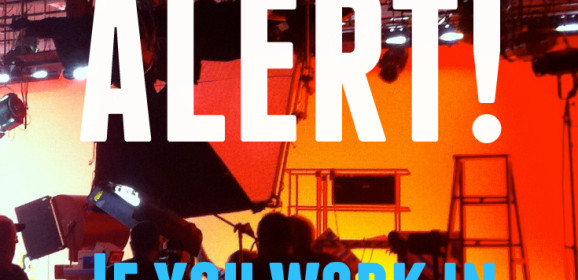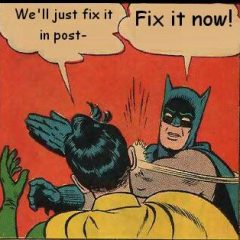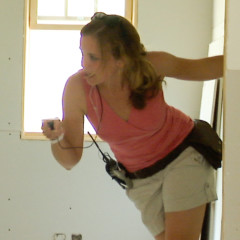The Best Movie Set Memes of 2016
Are you a member of Movie Set Memes? If not, you NEED to be. It’s a Facebook group devoted to inside jokes in the industry, using the internet’s most common memes. If you’re new to the business, it’s also a great way to learn on set lingo. You should probably devote half an hour to your day scrolling through the various memes. It’s worth it! For now, I’m sharing some of my favorites from 2016. The Best Movie Set Memes from 2016 PA Baller Tip: Use the lid plugs! “Copy That” Overly Ambitious Company moves ALWAYS take longer than you think they will. Filming in Los Angeles By the way, the application fee alone is $660. Don’t Be An Idiot You’re on your feet all day – make sure you wear something with good arch support! (Merrells or Nike Flyknits are awesome.) Possessive Electricians It’s for your own safety. Not Experience Remember: Film school can help, but it doesn’t equate to real world experience. Wasted Sleep I once worked on a show where I wrapped at 11pm, went home, and didn’t receive the call sheet until 2am…and my call time was 6am. Every Time Although to be fair, usually it’s because the Director yells, “CUT!”(…and everyone else then shouts, “TAILSLATE TAILSLATE TAILSLATE”) #EditorLife 4K may be awesome, but it is a b*#% in post. 8 Hour Days Not Sure If… When you’re a producer’s assistant, you might have to get creative about how you source things… Four Months of 14 Hour Days Hope There’s An Elevator “Camera Wrap” and “Taillights” are two different things. Ghost Walkie Also, what’s up with these voices in my head? Room Tone All Pay Is Not Equal Slaters Gonna Slate “Tryin’ to catch me clappin’ dirty…” Fix It Now! Yeah, you can fix some things in post, but you can’t fix bad content… Also Every Time Yep. ALL the noises. Classic Technically older than 2016, but a classic! What was your favorite Movie Set Meme of 2016? Meme Sharer Credit: Amanda D., Brandon C., Eduardo D., Itai F., James L. Jason S. P., Jenny D., Raki B., Sanal R., Rebecca S., David S., Eric V., Jack B. Nathaniel S., Riley T., Will S., Zachary E. All memes found on the hilarious Facebook group, Movie Set Memes....
Social Media Etiquette on Film Sets
Everyone knows amazing or awesome photos/events gain the most traction on social media. When your job happens on a film set, these brag-worthy moments happen frequently. But what are the do’s and don’ts? If you’re just starting out, it is VITAL that you pay attention to your surroundings, do your job, and forget about social media. In one of my college courses, my professor told us, “You’re entering into the entertainment industry, which means you’re a professional. Never act like a fan, or you will be fired.” Wise words. Social Media Etiquette on Film Sets: Posting Photos from Set It’s true, kids: There once was a day when people took photos and didn’t IMMEDIATELY post them online. In my PA days, I’d occasionally take wide shots of set from my lockup, just so I’d have something to remember those days with. They weren’t for the masses, and that was okay. Social media is an extension of life now. I constantly see interns or new PAs pulling out their phones the moment anything cool happens, and then immediately posting it on Instagram or Snapchat. Sometimes, this may be fine– but sometimes, it may get you fired. It’s important to know how to abide by basic social media etiquette on set, so here are guidelines that I’ve adapted for myself over the years. I’m pretty conservative in how much I share for the sake of remaining employed. Some have gotten away with posting more, but that’s their prerogative. OK: Posting a photo of you on set or with a fellow crew member. These are by far the most common “on set” photos that appear in social media. They’re fun, they’re cute (look at the three of us– don’t you want to hire us all?!), and they’re also a great networking tool as other freelancers will learn your name and see your face. Keep in mind that the crew you’re on set with will likely also see those postings. If it’s a particularly hectic day and you’re off posing for photos with some extras instead of doing your job, you may not be asked to come back. Be smart. Wait for a moment of downtime to take your photo. OK: Posting a photo of cool gear or a crazy gear setup. This is probably the most acceptable type of photo! It celebrates the craft, it appreciates the methodology, it shows that you realize that this is an extra complicated or special setup. Sometimes OK: Posting a generic photo of the set. I know several people who work on scripted television series on major networks. They never post generic photos of set — usually, it’s a shot of a sunrise, or the view from set. The...
How to be a Production Assistant: Watching First Team
The duties of production assistants on major motion pictures and scripted television get divvied up into four main responsibilities: first team PA, walkie PA, distro PA, background PA. (Sometimes walkie and distro are combined.) When you’re the background PA and there is no background, you may be asked to assist with “keeping eyes on First Team”. What is “keeping eyes on First Team”, and how do you do it? “First Team” – Definition First Team refers to the main actors of the movie or television show, plus any additional players that have lines on-camera. If you’re not sure who “First Team” is on a given day, consult the “CAST” section on the front of your callsheet: Looks like an easy day, only 4 people on first team today! First Team: Dissecting the Call Sheet The # column: These assigned numbers are how characters are kept track of for paperwork purposes — such as AD breakdowns, schedules, etc. Cast column: The actor’s name. For super-famous actors — let’s say, Tom Hanks — the 2nd AD may change the name here in the event that the call sheet fall into the wrong hands. Note: The AD will occasionally change the name for up-and-coming actors as well. Don’t make the mistake I almost made and refer to the actual up-and-coming actor by their made-up name. Character: Self explanatory… the character’s name. Status: This column makes you aware of whether the actor is beginning, in the middle of, or finishing their stint on the project. WS: Starts Work (first day); W: Working, WF: Work Finished (last day), SWF: Start Work Finish (dayplayers: their first and last day), H: Hold (technically not working, but may be called in). WD: Work drop (actor works today and will then be off the project for seven days or more), PW: Pickup work (actor returns after being dropped), PWF: Pickup Work Finish (actor returns after being dropped and completes task). Call: This is the time that they are due in basecamp. Pickup times are notated in the following column. Set: This is the time the actors are due– makeup and wardrobe ready– on set. First Team Duties – Start of Day The 2nd 2nd AD (sometimes first team PA) will check in with all the actors in the morning. They’ll make sure the actors have arrived to basecamp and are “in the chair” (hair/makeup trailer). First Team PA either gets the breakfast order for the cast if they have time, but usually they will need to stay in basecamp. They will then relay the orders to another PA. First Team Duties – On Set Once camera is ready, the actors needed for that scene will be shuttled...
Gift Ideas for Filmmakers, Producers, Film Students, Etc
What to you give to the person that works 15 hour days on film sets? Dr Scholl’s inserts? A gift card for a massage? Those actually aren’t horrible ideas for stocking stuffers (I love a good massage- especially after long shoot weeks), but they aren’t exactly on theme. So, here’s are a list of goodies I’ve found useful over the years that would make fantastic gifts. It’s broken into three categories: On Set for those who are currently in the biz; Learning Tools — for those just starting out, or students; or Just for Fun — affordable gifts with a film industry theme. So, whether your loved one is currently a filmmaker, wants to work on sets, a film student, or a high school student, here’s a list of gift ideas. Gifts for Life On Set Goldfold Callsheet Wallet A callsheet wallet will make life infinitely easier for assistant directors and production assistants. I also think it commands a little bit of respect! I’ve happily promoted Goldfold for years, as it’s truly the best product on the market. Made by hand by a 1st AD in Hollywood, Goldfolds are designed and engineered with practicality in mind. Buy a Goldfold callsheet wallet from Goldfold.com for $150 Portable Phone Charger A handy little external battery pack is a game-changer. I became hooked the first day on set I used one: In the middle of a rodeo, nowhere near an outlet or any kind of electricity! I simply plugged in and slipped the portable charger into my back pocket. Production life is stressful enough without agonizing over how to make 14% battery last for the final critical hour of the shoot. Buy a portable phone charger from Amazon – $15-$40 Hip/Belt Bag I’ve crowed about hip bags before. Production assistants are expected to carry a wide array of things on them at all times: cell phone, notebook, sharpies, pens, flashlight, leatherman, call sheets, extra sets of sides, etc — and having an extra pouch is a huge help. Happy Cow’s hip and belt bags are made out of recycled leather, are durable, and stylish. They come in a wide array of styles, for gals and guys. I purchased mine in 2011 and it’s still holding up, but they have raised their prices. Amazon has comparable options for almost half the price. Buy a belt bag from Happy Cow or Amazon – $30 – $120 iPad / iPad Mini This may be a bit obvious — who wouldn’t want an iPad? — but they’re extremely versatile on set! There’s a wide variety of industry apps that make life so much easier. You can use an iPad as a slate for generating timecode, obtaining release photos and signatures, filling...
Film Gear Essentials: The Hip Bag
Recently, I’ve been thinking about gear I use on film sets that I couldn’t live without. For years, I’ve had this page — a list of all of the gear I used and loved as a production assistant. I’m finally taking it one step further, by giving you an in-depth review of gear I’m particularly passionate about — what I consider to be “on set essentials”. Confession time: I wear a hip bag at work… and I love it. Before you think I’ve gone bonkers, let me explain. Hip bags, waist packs, fanny packs, bum bags, even a basic tool pouch — are INCREDIBLY useful for the demands of television and film sets. And so I don’t lose all credibility, I’m not talking about the frumpy dad fanny pack (although I guess you could choose that style to be ironic). Why I Love It I’ve used a leather hip bag – or leather hip belt with pouch, whatever you’d call it – for most of my production career. I originally bought it to replace my purse for my overseas adventures — but I quickly realized how practical it was for my daily on set life. I’m constantly on the move and need a LOT of stuff within my reach at all times. My little bag contains my cell phone, call sheet/sides, leatherman, pens, notepad, petty cash coin pouch, and most importantly, my external battery charger. (I also use the opposite side of the belt to clip my walkie and comtek.) When I first started out, I was wearing cargo shorts — mostly to have enough pockets to hold all of the aforementioned crap. As a result, I was constantly tightening my belt to keep my shorts from falling down. As my career progressed, I wanted to dress a little nicer – so I ditched the cargo shorts and embraced the hip bag. Plus, I feel like a badass while wearing it. Who Uses a Hip Bag? Almost every department will carry some sort of bag or pouch on their person — but the type and amount of gear you’ll need to carry will dictate the size and style. In my experience, these leather and canvas bags are most commonly worn by production assistants, assistant directors, story and field producers, associate producers, production coordinators, and occasionally art department. Examples of the Leather Hip Bag My go-to for the last five years has been a cleverly styled leather pouch with three zippered compartments and two pouches. It’s held up pretty well under the duress of set life, and of all the hip bags in the world, it looks the least like the dorky Disney fanny pack and more like something Lara Croft or an assassin would wear. There are...
Ask a Producer: Was I Just Fired?
I recently received a tricky question: How can you tell if you were fired from a film or tv job? I was supposed to work as a PA on a film set for the whole week, but after the first day, the line producer told me they only needed extra help on the first day. Should I tell them I’m willing to do anything else they need? Is this a sign I made a bad impression and they cut me off? Or should I just say “thank you for the opportunity” and look for a new job? Having a gig cut short unexpectedly sucks, but it does happen. I was recently signed on for a full 2-week gig, only to have it cut down to one week — and then cut down to 1.5 days. There are several reasons a job can be cut short. The production company may have run into bigger issues: They can’t get insurance, can’t get past final creative approvals from the network or ad agency, the talent is suddenly unavailable, etc, etc. But there is also the chance that your gig was cut short due to something you did. And very, very rarely will anyone explain to you why — especially if you’ve been fired. Trying to solve the riddle, I asked a few follow up questions: Sometimes, productions realize they don’t need the extra help and choose to save the money. And sometimes, it might be that they did let you go, whether due to some incident or because the director’s nephew suddenly needed to be added as a PA. Was it an out of town production company? Did anything seem amiss during the day? Either way, I wouldn’t beat yourself up. This has happened to me, as well. It’s the nature of the freelance beast and it’s unfortunate, but it’s their loss, in the end. People can be very fickle in this industry, and it’s very possible you did nothing wrong! He responded: Yes. It was an out of town production, and I should also mention this is a crowdfunded independent film. I was late and I was supposed to bring breakfast to the crew and failed to do so on time. Despite all this, I still want to network with these people. Ahhh. Let’s talk about breakfast on set first. Breakfast is a big morale boost for the crew before a long day of shooting begins, especially if the crew is already working for discounted rates. It’s a small morning ritual prior to every shoot: Everyone will take a quick minute to grab a coffee, eat a bite of a sandwich, and...









 I'm Laryssa, and when I'm not working in film or television, I'm attempting to travel -- or I'm here, providing resources for working in film or travel.
I'm Laryssa, and when I'm not working in film or television, I'm attempting to travel -- or I'm here, providing resources for working in film or travel. 









